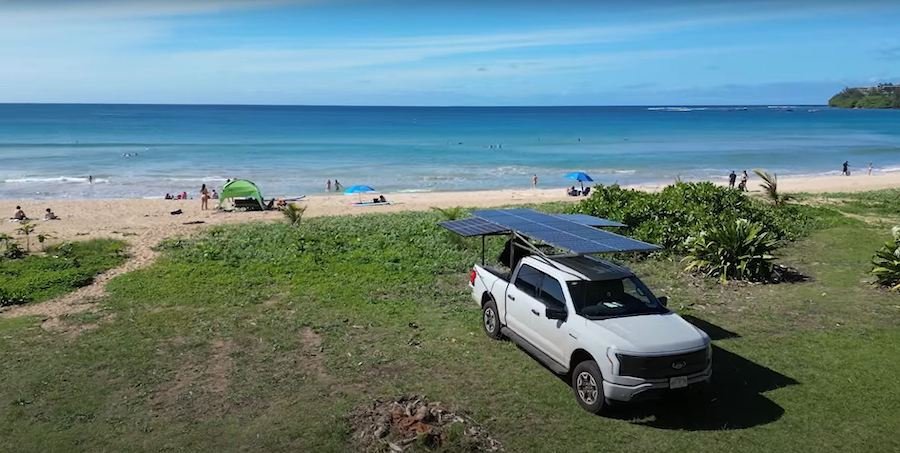Two Cousins Built This "Solar-Powered" Ford F-150 Lightning

It entered a very conservative business sector with hopes for a better future and managed to rise to fame and reach profitability after only 17 years since its official establishment. But legacy auto brands have been playing catch-up. Ford's F-150 Lightning is a good example in this regard. Two cousins took it upon themselves to make the all-electric truck even more environmentally friendly than it already was. Here's how they've done it and why it's important to keep seeing such initiatives come to fruition.
Electric vehicles appeared as a necessity. Scientists, public officials, and businessmen knew our world was heating up. The data showed that transportation plays a big part in global warming. So, the battery-electric vehicle was perceived as the solution. No exhaust system meant no greenhouse gas emissions.
Since General Motors killed the promising EV1, which could have been a true pioneer, the one EV that made it past the prototype phase was the Tesla Roadster. One even went to space! Shortly after the Roadster got the ball rolling, the Model S followed. Still, nobody believed Tesla would amount to anything significant. But people were curious, and the brand had the fortune of enjoying a community of early adopters who were very willing to spread the word in exchange for some perks.
Fast-forward a few years, and Tesla has reached a point where its EVs are popular worldwide. Moreover, its stock is loved by thousands of investors. Tesla quickly becomes one of the world's most important companies. The Model 3 and Model Y – the EVs for the masses – helped the American marque expand and conquer many more markets, including China. The latter even became the world's best-selling car in 2023.
Despite all this progress and Tesla forcing legacy automakers to make zero-tailpipe emission vehicles of their own, we still haven't taken the final step in the right direction. The problem with EVs is that they require big batteries. These high-voltage energy storage units are made of critical minerals that are obtained through destructive mining. Moreover, supply chains are yet to be shortened.
The US is incentivizing companies to make cells in North America, but it'll be a while before we see an EV battery that is mined, refined, packaged, transported, assembled, and installed in a US-made ride. EV motors aren't far off from this, either. They require magnets and even some materials known as "rare earths."
The bottom line is that a battery-electric vehicle comes out of the factory with a larger carbon footprint than a gas- or diesel-powered equivalent. After a few thousand miles, that discrepancy evens out, and the EV becomes more environmentally friendly. But the issue remains: the EV still isn't as green as we wanted it to be.
Then, other issues like pricey DC fast charging, high insurance rates, and costly registration appear. But we're not going to remind everyone about them in detail again.
Fortunately, we can do things to help the EV reach that carbon footprint parity with its internal combustion engine-powered rival faster. We can charge with renewable energy, drive the speed limit, and use features like the A/C system only when we really need to. That sounds great in theory, but it is actually harder to achieve in practice.
So, two Hawaii-based cousins figured out a way to make their Ford F-150 Lightning even greener. They added solar panels to it. Lightyear tried to bring the solar-powered car to market but failed. Aptera is just now preparing to put its small solar EV into production, but it doesn't look like it'll happen before the end of the year. So, it was now up to these two guys.
They built a rack that holds seven 330-watt solar panels and connected them to a portable power station. That extra battery is what's actually charging the pickup truck via a Level 2 plug. So, there's an energy loss of around 35% because of the DC/AC conversion.
Although it doesn't look like a commercially viable or sleek product, the implementation allows the pickup truck to take advantage of sunlight and add around 27 miles of range after spending approximately eight hours plugged in.
The cousins plan to update the rack's design in the future and want to add another solar panel. They also want to introduce hydraulics to allow the owner to control their position more easily and change the solar panels with more potent ones.
What you're about to see is obviously a homemade project made out of passion that could evolve into a viable product. The aerodynamic loss alone is enough to render the guys' efforts useless. We don't even have to think about the extra battery in the bed or the weight of the rack.
Still, it shows that by harnessing the power of renewable energy, we could help EVs become greener and really start to fight global warming. But maybe our first step forward should be to make smaller, more energy-dense batteries before moving onto such solutions.
Related News


